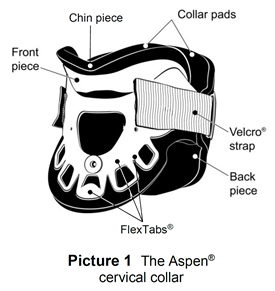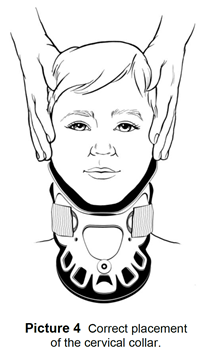Aspen® Cervical Collar
A cervical collar helps hold the neck in place. The neck area of the backbone is called the cervical spine. It’s made up of 7 bones supported by ligaments and muscles. When there’s an injury to the cervical spine, the neck needs to be held in place so it can heal.
A doctor or health care provider will place the Aspen® at the hospital. Before going home, you’ll learn how to put the collar on and how to take it off. Follow the wear-time guidelines given by the doctor or health care provider.

Taking the Collar Off
- The collar can be removed while lying flat or sitting up. Do not remove it on your own.
- Before removing the collar, check where the Velcro® straps end on the front of the collar (Picture 1).
When you put the collar back on, the Velcro straps should be in the same place.
- After removing the collar, replace the dirty pads with clean, dry pads. To clean the pads:
- Wash it with mild soap and water, then rinse it out. Do not use bleach or detergents.
- Gently squeeze out all the extra water.
- Let them air-dry. They will take about 6 to 8 hours to fully dry. Do not put pads in a dishwasher, washing machine, or dryer.
- Adjust the clean pads so the gray side grips the Velcro dots inside the collar. The pads must cover all edges of the plastic to keep it from touching the skin.
- To change the back pad, push the Velcro straps through the slits in the pad and then through the slots in the outer edge of the plastic.
Skin Care
It’s important to take care of the skin on your neck when wearing the collar. To avoid skin redness and sores, remove the collar once each day. While it’s off:
- Clean the skin with mild soap and water, then let it dry.
- Keep the skin clean, dry, and cool.
- Do not put powder or lotion on the neck where the collar will be.
Putting the Collar On
- To put the collar on, place the front of the collar so the chin comes to the front edge of the chin piece (Picture 2). If your child is wearing a pediatric-size collar, the chin must cover the chin dots found on the chin pad of the collar.
- Place the back panel behind your child’s neck (Picture 3). Check the writing on the Velcro straps to make sure the back is not being applied upside down.
- Attach the Velcro straps on the back piece of the collar to the front of the collar.
- Tighten one strap at a time until it fits snugly. For a pediatric-size collar, the green dots on the front of the collar must be covered by the Velcro straps.
- Bend the FlexTabs® if they’re uncomfortable.

Collar Placement
The collar is in the correct position if the chin comes to the front edge of the chin piece (Picture 4). The collar will have a snug fit.
For a pediatric-size collar, check these 3 things on the right side of the Velcro® strap:
- Are the chin dots hidden?
- Do the Velcro straps extend past the green dots?
- Are the FlexTabs® bent?
Occipital Support Strap™ (OSS)
The occipital support strap gives the neck more support. It’s the back piece of the collar (Picture 1).
- Tighten the strap by squeezing the back panel with one hand.
- Loosen the strap from one side and pull until it’s tight.
- Connect the strap to the Velcro patch.
- Repeat these steps for the other side of the occipital support strap.
Activity
While wearing the cervical collar, your child:
|
CANNOT |
CAN |
|
|
When to Call the Doctor
Call the doctor or health care provider if you:
- Have pain.
- Feel numbness or tingling in arms or legs.
- Have weak arms or legs.
- Seem to be getting worse instead of better.
HH-II-159 ©2007, revised 2023, Nationwide Children’s Hospital
